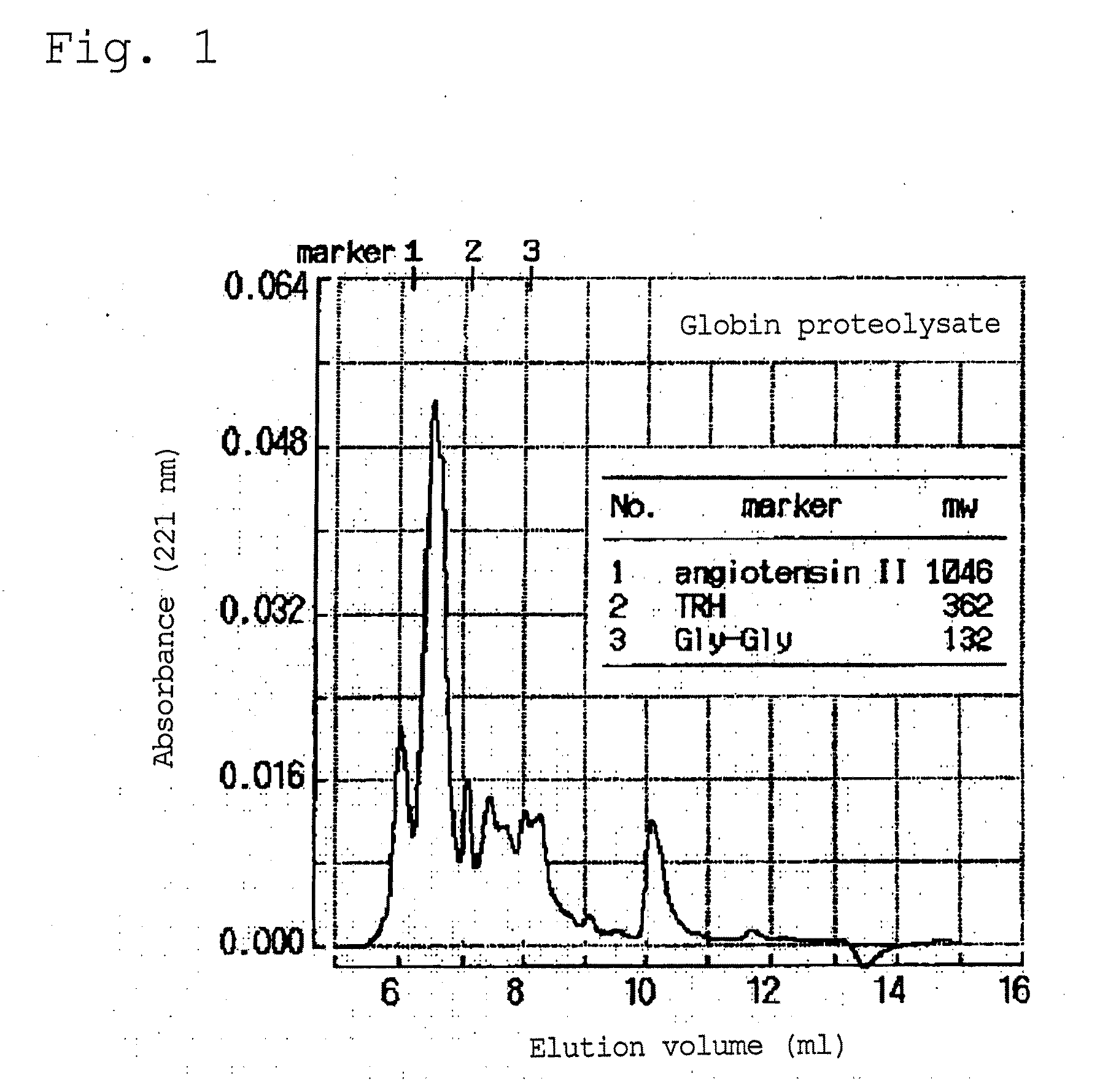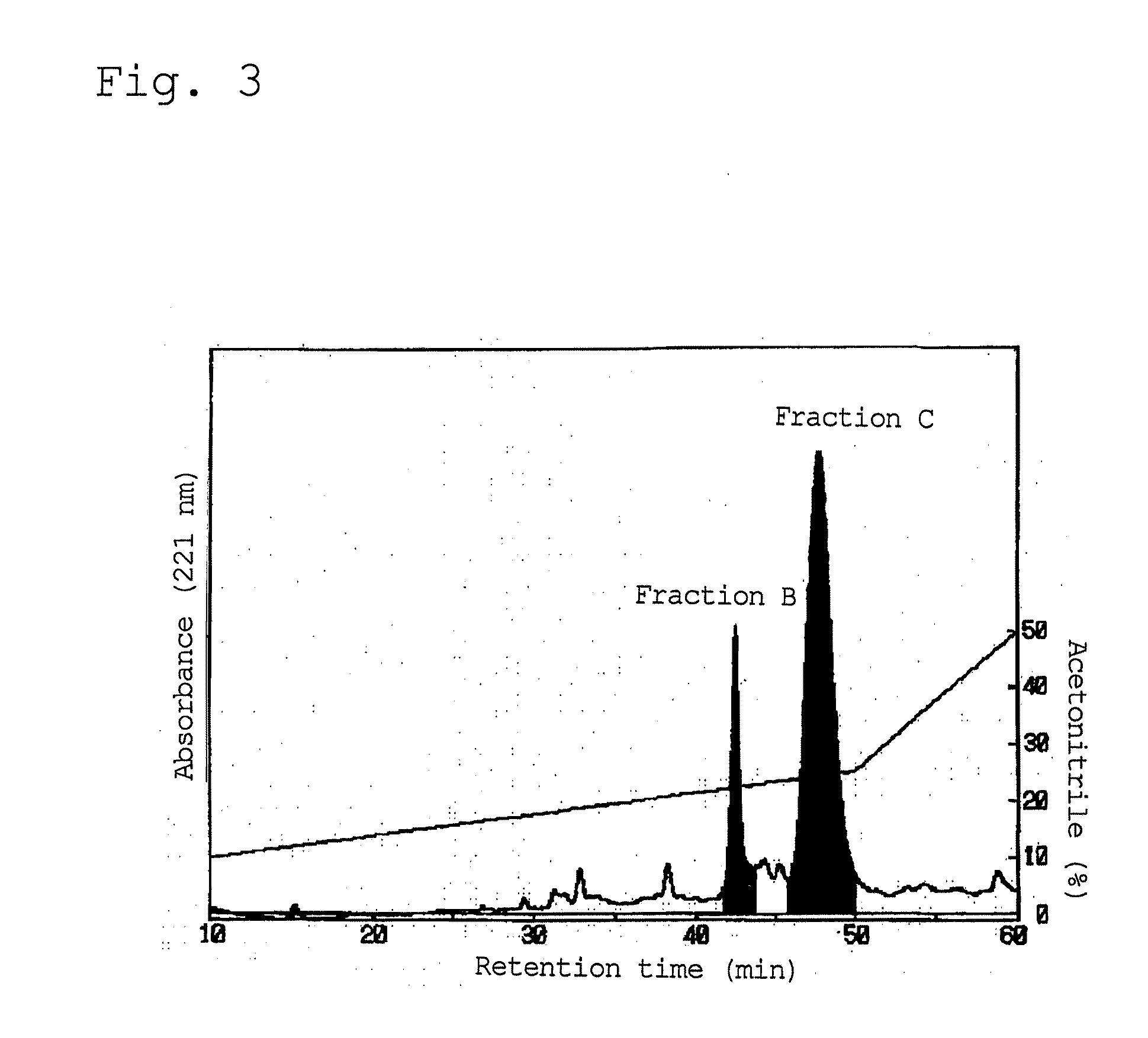Anti-hypertensive agent
a hypertension and anti-hypertensive technology, applied in the field of anti-hypertensive agents, can solve the problems of increased risk of cardiovascular complications caused by hypertension, and insufficient blood pressure control, so as to improve blood glucose levels, reduce blood pressure, and improve the effect of hypertension
- Summary
- Abstract
- Description
- Claims
- Application Information
AI Technical Summary
Benefits of technology
Problems solved by technology
Method used
Image
Examples
preparation example 1
Production of Globin Proteolysate
[0055]A method for producing a globin proteolysate using bovine erythrocytes is described below in detail.
[0056]250 liters of water was added to 100 kg of fresh bovine erythrocytes to allow sufficient hemolysis. After adjustment of the pH to 2.8 with phosphoric acid, 2.6×107 units of acid protease from Aspergillus niger were added to the solution, and the reaction was allowed to proceed at 50° C. for 3 hours.
[0057]After the reaction, the reaction mixture was heated at 80° C. for 30 minutes to terminate the reaction. Thereafter, an aqueous suspension of calcium hydroxide was added to the reaction mixture to adjust the pH to 6.5. Then, 10 kg of diatomaceous earth was added, and the mixture was filtered with a filter press. The resulting filtrate was spray-dried to thereby produce 23 kg of a globin proteolysate as a powder. The molecular weight distribution of the obtained globin proteolysate was examined by gel filtration chromatography, which was perf...
preparation example 2
Fractionation and Purification of Hypotensive Peptides
[0060]The peptide (VVYP) of the present invention was obtained by subjecting the globin proteolysate obtained in Preparation Example 1 to the following procedures: (1) ion exchange, (2) ultrafiltration, (3) separation by reverse phase column chromatography under acidic conditions, and (4) separation by reverse phase chromatography under neutral conditions.
(1) Ion exchange
[0061]A 10% aqueous solution containing 13.7 g of the globin proteolysate obtained in Preparation Example 1 was introduced to a weakly acidic cation exchange resin (Amberlite IRC50, H+ Type, Organo Co., Ltd.). After stirring for 1 hour for adsorption, an unadsorbed fraction was obtained.
(2) Ultrafiltration
[0062]The unadsorbed fraction obtained by the above ion exchange was subjected to ultrafiltration using a stirring-ultrafiltration unit (manufactured by Advantec, “UHP 90K”) and a ultrafilter membrane (manufactured by Advantec, “UIIH-1”, molecular weight cutoff:...
preparation example 3
Fractionation and Purification of Hypotensive Peptide
[0075]A 10% aqueous solution containing 100 g of the globin proteolysate prepared in Preparation Example 1 was adsorbed on an open column containing a reverse phase resin (YMC ODS AQ120 S50) (Φ0100 mm×400 mm), and eluted using hydrous ethanol as an eluate, while the concentration of ethanol was increased stepwise by 5 vol. % from 5 to 15 vol. %. Subsequently, the 5 vol. % ethanol-eluted fraction and the 15 vol. % ethanol-eluted fraction were subjected to reverse phase (acid) chromatography under the following conditions.
[0076]Equipment: High performance liquid chromatograph (Waters Alliance 2695-2996 (manufactured by Waters Corporation))
Column: Nucleosil 5C18 120 ÅΦ04.0×250 mm (manufactured by Chemco Scientific Co., Ltd.)
Eluate: Aqueous acetonitrile solution containing 0.1 vol. % trifluoroacetic acid
Gradient: an acetonitrile concentration of 5 vol. % at 0 to 5 min, a linear concentration gradient of acetonitrile of from 5 to 30 vo...
PUM
| Property | Measurement | Unit |
|---|---|---|
| systolic blood pressure | aaaaa | aaaaa |
| temperature | aaaaa | aaaaa |
| pH | aaaaa | aaaaa |
Abstract
Description
Claims
Application Information
 Login to View More
Login to View More - R&D
- Intellectual Property
- Life Sciences
- Materials
- Tech Scout
- Unparalleled Data Quality
- Higher Quality Content
- 60% Fewer Hallucinations
Browse by: Latest US Patents, China's latest patents, Technical Efficacy Thesaurus, Application Domain, Technology Topic, Popular Technical Reports.
© 2025 PatSnap. All rights reserved.Legal|Privacy policy|Modern Slavery Act Transparency Statement|Sitemap|About US| Contact US: help@patsnap.com



